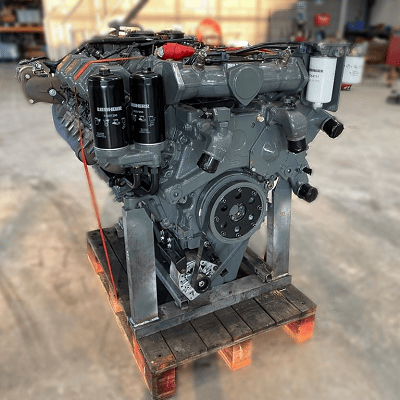The process of a dyno test on a Liebherr engine

When it comes to heavy machinery, reliability and power are paramount. Liebherr, a name synonymous with innovation and excellence in engineering, stands tall as a pioneer in the realm of heavy equipment and machinery. From towering cranes to robust excavators, Liebherr’s engineering prowess extends to the heart of these machines. We delve into the world of dyno testing a Liebherr engine, uncovering the meticulous process behind unleashing the raw power concealed within.
The foundation of excellence
Before we embark on the journey of dyno testing, it’s crucial to understand the foundation upon which Liebherr engines are built. With decades of engineering expertise and commitment to quality, Liebherr engines are crafted to withstand the most demanding environment and deliver unparalleled performance. Each component is meticulously designed and rigorously tested to ensure reliability, efficiency and longevity.
The process
1 Preparation: The engine undergoes meticulous preparation before being mounted onto the dynamo meter. This includes ensuring all connections are secure, fluids are filled to the appropriate levels, and sensors are properly calibrated.
2 Mounting: The engine is carefully mounted onto the dynamometer, a specialized device designed to simulate real-world operating conditions. Precision is paramount during this step to ensure accurate results.
3 Initial checks: Once mounted, a series of initial checks are conducted to verify proper alignment, connection integrity, and functionality of all engine systems.
4 Warm-up: The engine is started and allowed to warm up to operating temperature. This ensures consistent results and minimizes the risk of damage during testing.
5 Baseline testing: With the engine warmed up , baseline tests are conducted to establish initial performance metrics. This includes measuring power output, torque, fuel consumption, and emissions at various RPM levels.
6 Load testing: The engine is subjected to progressively increasing loads to simulate different operating conditions, such as idle, partial load and full load. This allows engineers to assess performance across the entire operating range and identify any potential issues or optimization.
7 Data analysis: Throughout the testing process, data is continuously collected and analyzed in real-time. Advanced instrumentation and software are used to monitor performance metrics and identify trends or anomalies.
8 Optimazation: Based on the data analysis, adjustments may be made to optimize engine performance. This could involve fine-tuning fuel injection timing, adjusting air-fuel ratios, or optimize turbocharger boost pressure.
9 Validation: Once testing is complete, the results are meticulously reviewed and validated against predetermined criteria and specifications. Any deviations or anomalies are thoroughly investigated to ensure accuracy and reliability.
10 Reporting: Finally, a comprehensive report is generated detailing the results of the dyno testing, including performance metrics, observations, and any recommendations for further optimization or refinement.
The outcome of dyno testing
Dyno testing a Liebherr engine is more than just a routine procedure – it’s a testament to the unwavering commitment to excellence that defines Liebherr’s engineering philosophy. By subjecting their engines to rigorous testing and analysis, Liebherr ensures that each engine delivers the uncompromising performance, reliability, and efficiency that customers expect.
In conclusion, dyno testing a Liebherr engine is not just about measuring power output. It’s about unlocking the true potential of these remarkable engines and ensuring they exceed expectations in the most challenging environments imaginable.
Stamping die frame: the perfect combination of manufacturing process and market development
With the rapid development of manufacturing industry, stamping die frame as an important processing tool has been widely used in automotive, aviation, electronics and other fields. This article will introduce the basic concept, design principles, production process, market status and development prospects of stamping die frame in detail to help readers better understand this field.
First, the basic concept of stamping die frame
Stamping die frame is a kind of die frame for stamping processing, which is mainly composed of upper die, lower die, die handle, guide post, guide sleeve and other parts. The role of the stamping die is to ensure the accuracy and stability of the mold installation, and to facilitate the stamping operation. According to the processing needs, the stamping die frame can be divided into simplex die frame and multi-station die frame.
Second, the design principle of stamping die frame
The design principle of stamping die frame mainly includes reasonable structure, accurate size and high precision. The structural design needs to be optimized according to product requirements and processing equipment to achieve a smooth and efficient stamping process. Dimensional accuracy is strictly required to ensure the stability and service life of the mold. High precision can improve product quality and production efficiency.
Third, the production process of stamping die frame
The production process of stamping die frame includes three links: processing, assembly and inspection. The processing link includes material selection, cutting, grinding and other steps, requiring strict control of errors. The assembly process needs to ensure the precision and stability of each part. The inspection link tests the overall performance of the mold frame to ensure that it meets the requirements of use.
Fourth, the market status of stamping die frame
At present, the market competition is fierce, and price and quality have become the key factors for enterprise competition. Some large mold enterprises have strong R & D capabilities and technical advantages, can provide high-end stamping die products, the price is relatively high. Some small and medium-sized enterprises rely on the low price strategy to provide middle and low-end products. In general, the quality of stamping products on the market is uneven.
Stamping Mould base,Automotive Electromechanical Products,Non-standard Mold Insert processing and manufacturing,Data Cable Interface
Shuaigang Mould Base (Yixing) Co., Ltd , https://www.shmouldbase.com
